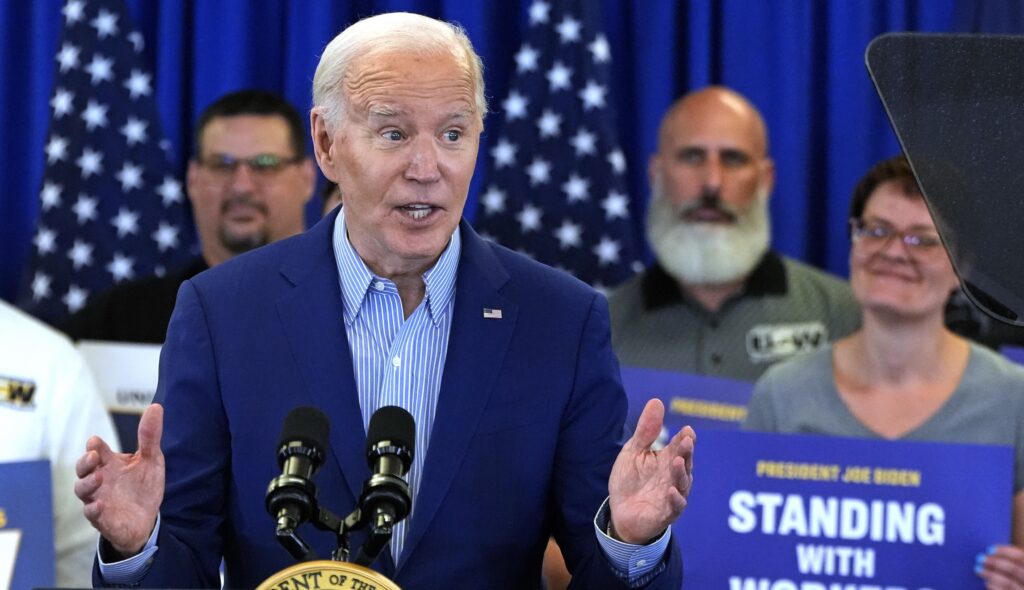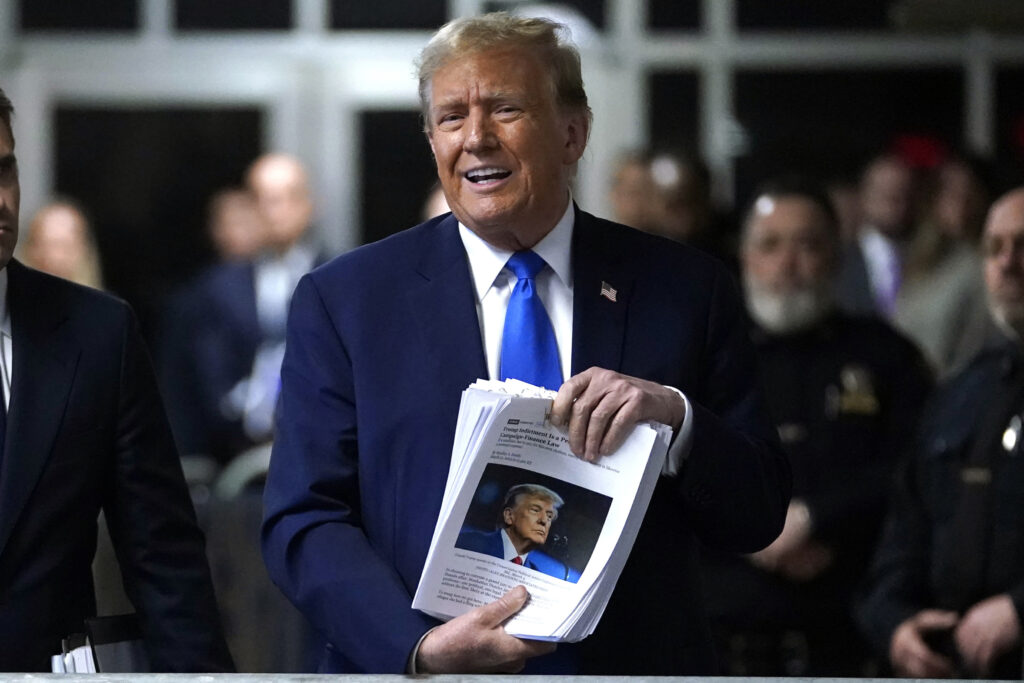
Pennsylvania is the ultimate battleground for 2024 with the White House, Senate, and House all poised to flip based on how voters here cast their ballots. In this series, Pining for Pennsylvania: Unlocking the crucial Keystone State, the Washington Examiner will look at the demographics, politics, and key topics that have made Pennsylvania the must-watch state of the year. Part Five, below, will look at how population shifts could account for the presidential election ending in a tie.
Pennsylvania is ground zero among the handful of critical battleground states that will decide the 2024 election for President Joe Biden and, to a lesser extent, former President Donald Trump.
After the 2020 Census, two battleground states, Michigan and Pennsylvania, lost one congressional seat each in Congress due to population losses, as did California, Illinois, New York, Ohio, and West Virginia.
ELECTION 2024: FOLLOW LATEST COVERAGE
In contrast, Texas gained two congressional seats while Colorado, Florida, Montana, North Carolina, and Oregon each gained one congressional seat.
Normally, the once-a-decade population changes would not have an outsize impact on a presidential election.
But population shifts in key swing states, most of which Biden won in 2020, changed the Electoral College landscape and have increased the likelihood of a possible electoral tie in November.
The election could be decided based on which candidate wins Pennsylvania.
“It’s [a] good ground zero,” said Vince Galko, a veteran Republican strategist in Pennsylvania. “It has been for the last several elections, but it seems more so this year than ever.”
If Biden loses the state, it will be much harder to defeat Trump, who either needs to win 270 electoral votes or get to a 269-269 tie to hold off Biden.
“Trump wins here, it’s over,” Galko said about the Keystone State. “If one state can determine your fate, it’s where you want to be, as evidenced by the fact that he was here multiple stops last week.”
Pennsylvania’s population loss in Biden territory
Much of the Keystone State’s population loss was in counties Biden won in 2020.
Looking at the Census Bureau’s changes to county-level population since the 2020 election, analysis from Franklin & Marshall College showed counties that voted for Trump in 2020 increased by roughly 4,500 people, while the 13 counties that supported Biden declined by more than 45,000 people.
The population losses in Biden counties are mostly attributed to Allegheny and Philadelphia counties, which had the largest net population declines, losing approximately 26,000 and 53,000 residents, respectively. Roughly half of Allegheny and Philadelphia residents who left moved to another part of the state, with many choosing to live in surrounding counties.
Sensing the importance of Pennsylvania, Biden has spent more time there than in any other battleground state.

The president held a three-day tour through Pennsylvania this week, seeking to portray himself as the champion of the middle class, in contrast to Trump’s chumminess with the billionaire class, in his childhood hometown of Scranton.
“It’s a stark contrast to Donald Trump and Republicans, who still have no announced staff and no campaign presence in this major battleground,” wrote campaign manager Julie Chavez Rodriguez in a memo this week.
Biden flipped the Keystone State in 2020 by just over 80,000 votes. But Trump aims to retake the state he won in 2016 by just over 44,000 votes.
“With just 36 percent job approval, Joe Biden is floundering in his home state of Pennsylvania,” Karoline Leavitt, Trump’s national press secretary, told the Washington Examiner in a statement. “Between higher gas prices, surging crime, and failed Democrat policies crushing families at every corner, it’s no wonder that Pennsylvanians across the Commonwealth are increasingly rejecting the failed Biden agenda and supporting President Trump.”
Biden also touted the endorsement of Robert F. Kennedy Jr.’s family members during a Philadelphia stop, a move meant to blunt the independent candidate’s campaign.
Kennedy is aiming to gain access to Pennyslvania’s ballot, but some skeptics doubt he could win.
“It is improbable that any third-party or independent candidate would win even one state and therefore get that state’s electoral votes,” said Bernard Tamas, an associate professor of political science at Valdosta State University. “Such scenarios would require one of the third-party or independent candidates to have public support that is heavily concentrated in one region of the country, and this has not happened since 1968, when George Wallace won multiple southern states.”
Trump, meanwhile, has mostly kept to New York, where he is facing a criminal trial over a hush money payment scheme during the 2016 election.
The former president has sought to make Biden’s campaign work harder in New York, a reliable blue state, due to the trial.
“Donald Trump has to get Joe Biden on the defense by spending time and money outside Pennsylvania and the couple of other battleground states,” Republican consultant Dennis Lennox said. “It’s hard to see Trump winning New York, but him playing there forces Biden to spend time and money in an otherwise blue state in the same way George W. Bush in 2004 distracted John Kerry from Ohio by playing in Michigan.”

How the 2024 election could end in a tie
In one general election scenario, Biden would hold on to Michigan, Pennsylvania, and Wisconsin, branded as the “blue wall,” with Trump flipping Arizona, Georgia, and Nevada.
That would result in Biden winning 270 electoral votes to Trump’s 268 electoral votes. But if Nebraska’s rules were changed, from awarding Electoral College votes by congressional districts to winner-take-all, the same scenario would result in a 269-269 tie.
In the event of an electoral tie, the House of Representatives would elect the next president of the U.S., according to the 12th Amendment. But the process isn’t a simple majority vote of the entire House. (More on that process below.)
Republicans are hoping to flip back the “blue wall” in 2024. The Republican National Committee scheduled its convention in Wisconsin and Trump has visited all three states in recent weeks.
“After four years of weak Joe Biden’s failed agenda, there is no ‘Blue Wall’ left,” RNC spokeswoman Rachel Lee said in a statement. “Biden is losing in every battleground state — just like he will in November.”
Another scenario of an electoral tie involves Biden winning Arizona, Georgia, Nevada, and Wisconsin while Trump wins Michigan and Pennsylvania, assuming Nebraska doesn’t change its rules on awarding electoral votes. But with a Nebraska change, it would result in Trump winning 270 votes to Biden’s 268 votes.
One political expert told the Washington Examiner that if Biden lost the Keystone State, he would need to sweep every other swing state to win the election.
“Of course, if [Biden] took North Carolina, that almost offsets Pennsylvania,” said Merrill Matthews, resident scholar at the Institute for Policy Innovation. “So my sense is he really needs to win Pennsylvania, but I think you could probably make it work the other way.”
If Trump flips Michigan, Nevada, Pennsylvania, and Wisconsin, and then Biden flips North Carolina and holds on to Georgia and Arizona, the scenario would also result in a 269-269 tie without a Nebraska change.
Trump could also flip Georgia, Michigan, and Pennsylvania, with Biden flipping North Carolina to get another 269-269 tie. If there were a winner-take-all system in Nebraska, it would give Trump a 270-268 lead over Biden.
What Trump is doing in Nebraska to eke out a tiebreaking advantage
The former president, running a far more sophisticated campaign than in previous years, aims to change how the Electoral College is decided to give him an advantage over Biden.
Trump unsuccessfully pressured Nebraska Republican lawmakers to change the state’s law to award electoral votes on a winner-take-all basis. But there are still some Republicans attempting to change Nebraska’s rules.
Notably, Gov. Jim Pillen (R-NE) and Rep. Don Bacon (R-NE) favored changing Nebraska’s rules.
If the effort does succeed later on, Biden would not win one of the state’s five electoral votes in the deep red state, most likely from the 2nd Congressional District, where he won an electoral vote in 2020.
Maine is the other state that awards electoral votes based on congressional districts. Trump won one electoral vote in Maine in 2016 and 2020 despite losing the state.
The Republican advantage in the House
If the election does end in an electoral tie, it would throw the race to the House of Representatives for a contingent election.
However, the current members of the House would not decide the election. That would be left to the next members of Congress, who will also be on the ballot during the Nov. 5 elections and sworn into Congress in January 2025.
Each state delegation gets a single vote during the process that is decided by a majority vote. In 2024, Republicans control nearly the majority of state delegations, 25 out of the 50. Democrats control 23 House delegations with Minnesota and North Carolina both split.
Either Biden or Trump would need to win 26 House delegations to win the election in the event of an electoral tie.
North Carolina’s redrawn maps give Republicans the advantage, 10 Republican seats to three Democratic seats with one competitive seat, which could give Trump the coveted 26th vote needed for victory. In Minnesota’s 2nd Congressional District, Rep. Angie Craig (D-MN) has the only competitive seat in that state this year.
“Even if the Democrats win a majority in the House, that’s not going to guarantee a Biden win in this type of scenario,” said J. Miles Coleman, associate editor of Sabato’s Crystal Ball at the University of Virginia Center for Politics. “Even after 2020 when the Democrats were still in the majority, an electoral tie would have still favored Trump.”
In 2020, despite controlling the House, Democrats only controlled 23 House delegations while Republicans controlled 26 and Pennslyvania was split.
Pennsylvania’s delegation has nine Democrats to eight Republicans, meaning it would back Biden in the case of an electoral tie. But with Democrats in control of more competitive seats, there is a possibility Republicans could win the majority of the delegation after November.
The Senate, meanwhile, would select the vice president with each senator getting a single vote if there were an electoral tie.
CLICK HERE TO READ MORE FROM THE WASHINGTON EXAMINER
But if there is a contingent election, Elaine Kamarck, a Brookings senior fellow in the governance studies program and director of the Center for Effective Public Management, said the election could come down to tense internal deliberations among state congressional delegations.
“My guess is they have to keep voting,” Kamarck said. “And at some point, somebody in one of these delegations would change their mind and flip the delegation. One or two people would flip the delegation and would probably do it in favor of whoever won the national popular vote.”



